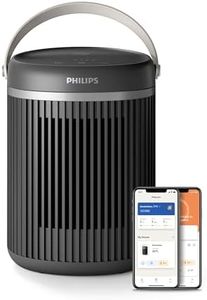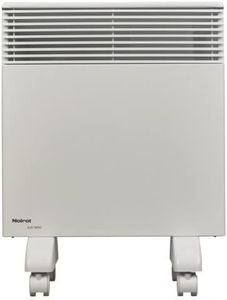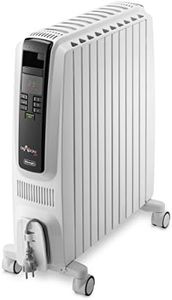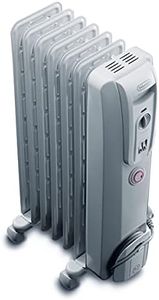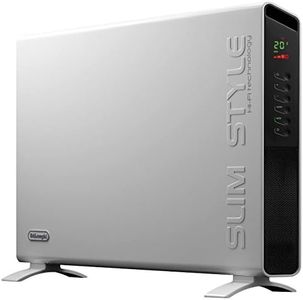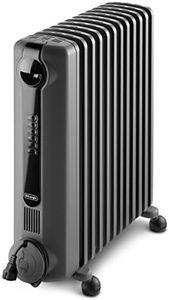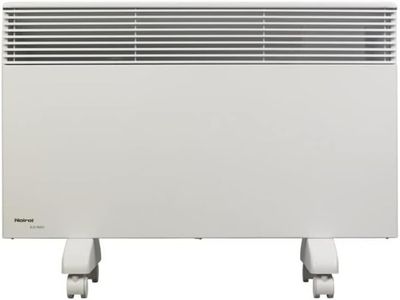We Use CookiesWe use cookies to enhance the security, performance,
functionality and for analytical and promotional activities. By continuing to browse this site you
are agreeing to our privacy policy
10 Best Most Efficient Electric Heaters
From leading brands and best sellers available on the web.Buying Guide for the Best Most Efficient Electric Heaters
Choosing the most efficient electric heater for your space can make a big difference in both comfort and energy use. It's important to think about the room size, how long you’ll use the heater, and any safety or convenience features you might want. Efficiency is not just about how much power the heater uses, but also how well it warms up your room and how well it holds onto that heat. To help you find the best fit, let's go over the most important features and specifications that influence energy efficiency and overall user satisfaction.Power Rating (Wattage)The power rating, shown in watts (W), tells you how much electricity the heater consumes and roughly how much heat it can produce. Higher wattage heaters can heat larger spaces or warm up a room more quickly, while lower wattage units are suitable for small rooms or personal use. Typically, for small bedrooms or offices, a heater around 750 to 1500 watts is appropriate. For larger living rooms, something closer to 2000 watts may be necessary. Choose a heater whose power rating matches your room size and heating needs—more power doesn’t always mean more warmth if the room is too large, but using a high-wattage heater in a small space can use unnecessary electricity.
Heating Technology (Convection, Radiant, Fan, Oil-filled, etc.)This specification indicates how the heater produces and distributes warmth. Convection heaters warm the air and are great for heating entire rooms. Radiant heaters directly warm objects and people in their path, working well for spot heating. Fan heaters spread warmth quickly but can dry the air. Oil-filled heaters retain heat longer and provide steady, silent warmth. Your choice should depend on how you plan to use the heater; for whole-room heating, convection or oil-filled types are generally best, while radiant and fan heaters are more suited for personal or quick heating.
Thermostat and Temperature ControlA heater with a thermostat allows you to set the room temperature, and the heater will turn on or off as needed to maintain that level. This feature is important for efficiency, as it helps avoid overheating and unnecessary energy use. Some heaters offer digital thermostats with precise temperature settings, while others have simple dial controls with low, medium, and high options. For those seeking convenience and energy savings, pick a heater with an adjustable thermostat—especially a digital one if you want more exact temperatures.
Timer FunctionA timer lets you schedule the heater to turn on or off automatically, which can help save energy and provide comfort when you need it most. Timers can usually be set for a certain number of hours or for specific start and stop times. If you want a heater to warm up your room just before you wake up or return home, or to turn off automatically after you’ve gone to bed, this feature is particularly useful. Consider your daily routine to see if a timer would make your heating both easier and cheaper.
Safety Features (Tip-Over and Overheat Protection)Safety features are essential for peace of mind, especially if you have pets or children. Tip-over protection shuts off the heater if it falls over, while overheat protection turns it off if it gets too hot. These safeguards prevent accidents and potential fire risks. When comparing models, always check for these features if you’ll use the heater in a home setting—especially in busy or high-traffic areas.
Portability and SizeThis spec refers to the heater’s weight, handles, wheels, and overall size. For those who need to move the heater from room to room, or who have limited space, a compact and lightweight model is ideal. Larger heaters might be less convenient to move but often provide more powerful heating. Think about where you’ll be using the heater and if you need to store it when not in use—your daily habits should guide how portable or compact your chosen heater should be.
Energy Efficiency Features (Eco Modes, Programmable Settings)Some heaters offer special energy-saving modes that automatically adjust power output or cycling to maintain comfort while using less electricity. Others have programmable settings that allow you to create a heating schedule. If you’re interested in minimizing costs and waste, look for these energy efficiency features and consider how much control you’d like over your usage patterns.



